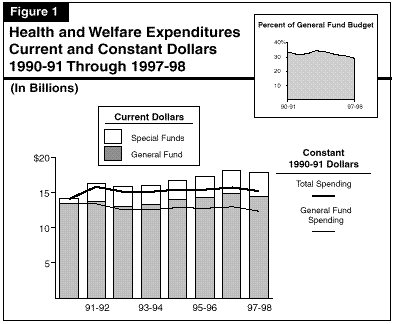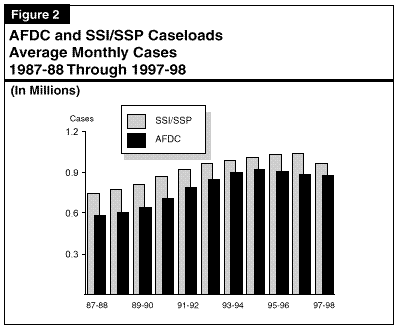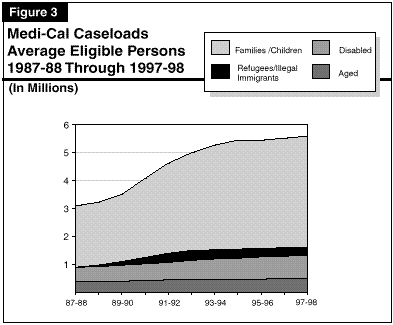![]() Governor
Proposes to Eliminate County Mandate to Provide General Assistance
Governor
Proposes to Eliminate County Mandate to Provide General Assistance
![]() $484 Million
in State Savings Depends on Federal Action
$484 Million
in State Savings Depends on Federal Action
![]() Budget
Proposes to Make Temporary Grant Reductions and Cost-of-Living Adjustment Suspensions
Permanent
Budget
Proposes to Make Temporary Grant Reductions and Cost-of-Living Adjustment Suspensions
Permanent
![]() Caseloads
Lower Than Projected in Budget
Caseloads
Lower Than Projected in Budget
![]() Budget
Reflects Savings from Federal Welfare Reform Provision Denying Noncitizens'
Eligibility for SSI/SSP Benefits
Budget
Reflects Savings from Federal Welfare Reform Provision Denying Noncitizens'
Eligibility for SSI/SSP Benefits
![]() Budget
Proposes to Eliminate State-Only Medi-Cal Program for Prenatal Services for
Undocumented Women
Budget
Proposes to Eliminate State-Only Medi-Cal Program for Prenatal Services for
Undocumented Women
Figure 1 (see next page) shows that General Fund expenditures for health and social services programs are projected to increase by $1.2 billion, or 8.7 percent, between 1990-91 and 1997-98. This represents an average annual increase of 1.2 percent.
In 1991-92, realignment legislation shifted $2 billion of health and social services program costs from the General Fund to the Local Revenue Fund, which is funded through state sales taxes and vehicle license fees. This shift in funding accounts for the significant increase in special funds starting in 1991-92, as shown in Figure 1. General Fund spending declined in 1992-93, due to various program reductions (the largest being welfare grant reductions). The following years reflect an upward trend in spending until 1997-98, when a reduction is proposed.
Combined General Fund and special funds spending is projected to increase by 27 percent between 1990-91 and 1997-98. This represents an average annual increase of 3.4 percent.
Figure 1 also displays the spending for these programs adjusted for inflation. On this basis, General Fund expenditures are estimated to decrease by 7.5 percent between 1990-91 and 1997-98. Combined General Fund and special funds expenditures are estimated, however, to increase by 7.9 percent during the same period, on a constant dollar basis. This is an average annual increase of 1.1 percent.
As noted previously, the 1991 realignment legislation significantly altered the financing of health and social services programs by transferring funding for all or part of several mental health, public health, and social services programs to the counties. The sales tax and vehicle license fee revenues dedicated to realignment amounted to $2 billion in 1991-92, which was $239 million short of the amount that was initially estimated. The budget estimates that realignment revenues will be $2.7 billion in 1997-98.

Figures 2 and 3 illustrate the caseload trends for the largest health and welfare programs. Figure 2 shows Medi-Cal caseload trends over the last decade, divided into four groups. Families and children (primarily recipients of Aid to Families with Dependent Children--AFDC), the aged and the disabled (primarily recipients of Supplemental Security Income/State Supplementary Program--SSI/SSP), and refugees and illegal immigrants. (Pursuant to the 1996 federal welfare reform legislation, AFDC is also referred to as Temporary Assistance for Needy Families, or TANF.)
Medi-Cal caseloads increased by 81 percent over the last decade. As Figure 2 shows, most of this growth occurred during the period from 1989-90 through 1994-95. The growth in the number of families and children receiving Medi-Cal during this period reflects the rapid growth in AFDC caseloads during this time as well as the expansion of Medi-Cal to cover additional women and children with incomes too high to qualify for cash aid in the welfare programs. Coverage of refugees and illegal immigrants also increased caseloads significantly during this period. Since 1994-95, overall Medi-Cal caseloads have grown much more slowly, due primarily to a slight decline in AFDC caseloads.

Figure 3 shows the caseload trend for the AFDC (Family Group and
Unemployed Parent components) and SSI/SSP programs. While the
number of cases in SSI/SSP is greater than in the AFDC Program, there are
more persons in the AFDC Program--about 2.6 million compared to about
1 million for SSI/SSP. (The SSI/SSP cases are reported as individual
persons, while AFDC cases are primarily families.)
Caseload growth in these two programs is due, in large part, to the growth of the eligible target populations. The increase in the rate of growth in the AFDC caseloads in 1990-91 and 1991-92 was partly due to the effect of the recession. During the next two years, the caseload continued to increase but at a slower rate of growth. This slowdown, according to the Department of Finance, was due partly to (1) certain population changes, including lower migration from other states; and (2) a lower rate of increase in "child-only" cases (including citizen children of undocumented and newly legalized persons), which was the fastest growing segment of the caseload until 1993-94. (For a discussion of other factors affecting the AFDC caseload during this period, please see our report on the program in The 1991-92 Budget: Perspectives and Issues, page 189.)

Figure 3 also shows that since 1994-95, AFDC caseloads have declined. As we discuss in our report, California's Fiscal Outlook (November 1996), we believe that this trend is due largely to various factors affecting welfare caseloads, including the improving economy, lower birth rates for young women, and a decline in legal immigration to California.
The SSI/SSP caseload can be divided into two major components: the aged and the disabled. The aged caseload generally increases in proportion to increases in the eligible population--age 65 or older. This component of the caseload accounts for about one-third of the total. The larger component--the disabled caseload--has been growing faster than the rate of increase in the eligible population group (primarily ages 18 to 64). This is due to several factors, including (1) the increasing incidence of AIDS-related disabilities, (2) changes in federal policy that liberalized the criteria for establishing a disability, (3) a decline in the rate at which recipients leave the program (perhaps due to increases in life expectancy), and (4) expanded state and federal outreach efforts in the program.
As the figure shows, the budget projects a significant reduction (6.8 percent) in the SSI/SSP caseload in 1997-98. This is due to the provision in the federal welfare reform legislation of 1996 which makes legal noncitizens ineligible for the program.
1. The Budget Proposes to Fund Basic Caseload Changes. This includes funding for a projected caseload increase of 0.5 percent in the Medi-Cal Program, a decrease of about 1 percent in the AFDC Program, and an increase of 1.8 percent (before adjusting for policy changes) in SSI/SSP.
2. The Budget Reflects a Significant Shift of State Costs to the Federal Government. This would be accomplished by the following actions:
| Figure 4 | |||||
| Major Health and Welfare Programs Budget Summarya
1995-96 Through 1997-98 | |||||
| (Dollars in Millions) | |||||
| Actual
1995-96 |
Estimated
1996-97 |
Proposed 1997-98 | Change From 1996-97 | ||
| Amount | Percent | ||||
| Medi-Cal | |||||
| General Fund | $6,252.9 | $6,908.4 | $6,943.1 | $34.7 | 0.5% |
| All funds | 16,479.1 | 18,411.5 | 18,394.2 | -17.3 | -0.1 |
| AFDC (FG&U) | |||||
| General Fund | $2,712.4 | $2,228.7 | $1,965.7 | -$263.0 | -11.8% |
| All funds | 5,607.2 | 5,165.8 | 4,620.1 | -545.7 | -10.6 |
| AFDC (FC) | |||||
| General Fund | $293.2 | $336.3 | $353.8 | $17.5 | 5.2% |
| All funds | 1,176.7 | 1,190.7 | 1,408.3 | 217.6 | 18.3 |
| SSI/SSP | |||||
| General Fund | $2,050.6 | $2,069.9 | $1,660.3 | -$409.6 | -19.8% |
| All funds | 5,586.3 | 5,731.1 | 5,066.1 | -665.0 | -11.6 |
| County welfare
administration |
|||||
| General Fund | $477.4 | $491.8 | $560.3 | $68.5 | 13.9% |
| All funds | 1,833.7 | 1,993.8 | 2,049.3 | 55.5 | 2.8 |
| In-Home Supportive
Services |
|||||
| General Fund | $254.1 | $331.3 | $375.3 | $44.0 | 13.3% |
| All funds | 924.6 | 1,061.0 | 1,167.6 | 106.6 | 10.0 |
| Regional centers/
community services |
|||||
| General Fund | $395.6 | $453.1 | $488.9 | $35.8 | 7.9% |
| All funds | 943.0 | 1,045.0 | 1,151.7 | 106.7 | 10.2 |
| Developmental centers | |||||
| General Fund | $30.7 | $31.2 | $33.4 | $2.2 | 7.1% |
| All funds | 567.2 | 532.7 | 442.4 | -90.3 | -17.0 |
| Child welfare services | |||||
| General Fund | $318.0 | $333.3 | $349.7 | $16.4 | 4.9% |
| All funds | 967.6 | 1,061.2 | 1,064.9 | 3.7 | 0.3 |
| State hospitals | |||||
| General Fund | $199.6 | $215.1 | $247.3 | $32.2 | 15.0% |
| All funds | 435.1 | 464.0 | 456.1 | -7.9 | -1.7 |
| a Excludes departmental support. | |||||
| Figure 5 | |||||
| Health Services Programs
Proposed Major Changes for 1997-98 General Fund | |||||
| Medi-Cal | Requested: | $6.9 billion | |||
| Increase: | $35 million | (+0.5%) | |||
| +$93 million for caseload increase | |||||
| +$376 million due to higher utilization of services and other cost increases | |||||
| +$50 million for increased costs to reimburse certain hospitals for their capital project debt | |||||
| +$43 million (including $23 million transferred from the Office of Family Planning) for the full-year costs and expansion of the family planning program | |||||
| +$25 million for a new drug--human growth hormone--for the treatment of AIDS | |||||
| |
|||||
| -$216 million by assuming federal reimbursement for emergency services for undocumented persons | |||||
| -$112 million from an increase in the federal cost-sharing ratio | |||||
| -$80 million by eliminating the state-only program for prenatal care for undocumented persons | |||||
| Public Health | Requested: | $308 million | |||
| Decrease: | $12 million | (-3.7%) | |||
| +$16 million due to increased caseload and costs for the AIDS Drug Assistance Program | |||||
| Figure 6 | |||||
| Social Services Programs
Proposed Major Changes for 1997-98 General Fund | |||||
| AFDC/TANF and
Employment Services |
Requested: | $2.1 billion | |||
| Decrease: | $237 million | (-10%) | |||
| +$80 million for employment services (CalTAP proposal) | |||||
| |
|||||
| -$245 million (cost avoidance) by not restoring the statewide 4.9 percent grant reduction and the cost-of-living adjustment | |||||
| -$156 million by revising the grant structure (CalTAP proposal) | |||||
| -$74 million due to a decline in basic caseloads | |||||
| County Welfare Administration | Requested: | $560 million | |||
| Increase: | $68 million | (+14%) | |||
| +$93 million to train caseworkers and pay for increased data processing costs for the proposed CalTAP. | |||||
| SSI/SSP | Requested: | $1.7 billion | |||
| Decrease: | $410 million | (-20%) | |||
| -$153 million to reflect federal provision eliminating most legal noncitizens from SSI/SSP | |||||
| -$66 million by assuming federal legislation to implement the regional 4.9 percent grant reduction (current state law) | |||||
| -$213 million by assuming federal legislation to implement statewide 4.9 percent grant reduction. | |||||
| In-Home Supportive
Services |
Requested: | $375 million | |||
| Increase: | $44 million | (+13%) | |||
| +$90 million (and $37 million in current year) due to increases in the minimum wage | |||||
| |
|||||
| -$22 million due to legal noncitizens' loss of eligibility resulting from federal welfare reform provisions for SSI/SSP | |||||
3. The Budget Reflects Savings From federal welfare reform Provisions Making Noncitizens Ineligible for Certain Health and Welfare Programs:
4. The Budget Proposes to Make Permanent Certain Grant Reductions and Cost-of-Living Adjustment (COLA) Suspensions in the AFDC and SSI/SSP Programs:
Our office has released a report that offers a different approach to redesigning the welfare system. (Please see Welfare Reform in California: A Welfare-to-Work Approach, January 23, 1997.) We discuss the Governor's proposal and our approach in detail in our analysis of the AFDC/TANF Program.
| Figure 7 | ||
| Governor's Proposal to Reform Welfare | ||
|
||
|
||
|
||
|
||